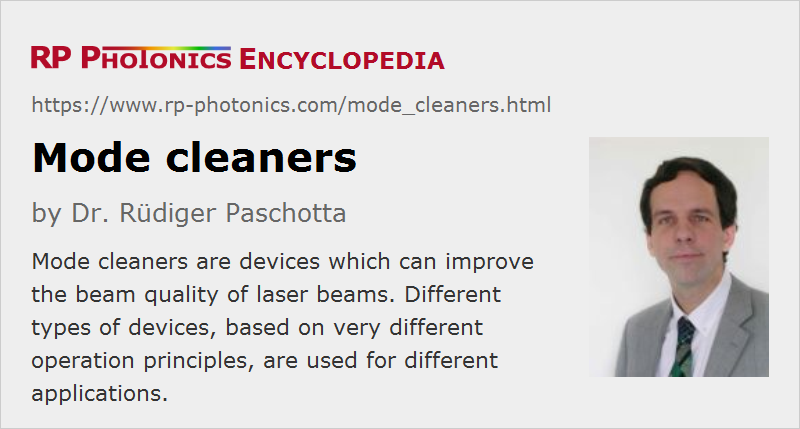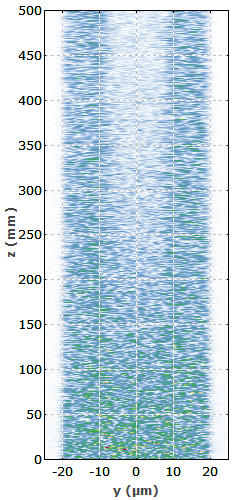Mode Cleaners
Definition: devices which can improve the beam quality of laser beams
Alternative term: spatial filters
Categories: general optics, photonic devices
How to cite the article; suggest additional literature
Author: Dr. Rüdiger Paschotta
For various reasons, laser beams often have an imperfect beam quality, i.e. distortions of their intensity and/or phase profile. Depending on the circumstances, various types of “mode cleaner” devices may then be used for “cleaning up” the beam profile. The term “mode cleaner” is actually imprecise, because what is cleaned is not a mode (which is a mathematical concept, not a physical entity), but rather the phase and/or intensity profile of a laser beam. Another frequently used term (at least for non-resonant mode cleaners) is spatial filter.
There are resonant and nonresonant types of mode cleaners, which are very different concerning their principle of operation and the range of application. Resonant mode cleaners, mostly called mode cleaner cavities, are discussed in a separate article. The following description concentrates on nonresonant devices.

A fundamental limitation for all mode cleaners is that it is physically not possible to have an optical device which concentrates all the optical power of a multimode beam into a single-mode beam (having perfect beam quality). However, if most of the beam power is in a single mode already, the beam quality can be improved by attenuating all other modes, and this will not lead to a substantial power loss. This principle is used by various mode cleaners. A different operation principle is that of a brightness converter, which however is a laser device rather than a combination of simple optical elements, and also changes the wavelength of the light.
Nonresonant Mode Cleaners
Figure 1 shows the simple setup, which can be understood relatively easily on the basis of Fourier optics. The (somewhat “spoiled”) beam coming from the left-hand side is focused to a small spot with a lens. In the focal plane, different spatial Fourier components of the original beam are to some extent spatially separated: each spatial Fourier component corresponds to a plane wave with a certain propagation direction, and a component which e.g. propagates slightly upwards will have its focus at a higher position. Therefore, the pinhole in the focal plane can effectively attenuate spatial components related to off-axis components. The second lens recollimates the beam, and the resulting beam has a “cleaned” intensity and phase profile. Of course, the cleanup cannot be perfect, since each spatial component is focused to a spot with finite size. Note that simply focusing more strongly will not necessarily help, since this also reduces the spatial separation of spatial Fourier components in the focal plane. However, a certain degree of focusing is required; a rule of thumb is that the waist size must be a few times smaller than the original beam size. Further, the diameter of the pinhole must of course be appropriate; too small a hole, for example, leads not only to excessive power loss but also to a deterioration of the beam quality.
The beam cleanup can work very well when an originally close to Gaussian beam (with high beam quality) has acquired some spatially “fast” distortions e.g. by reflection on some mirrors with deposited dust particles. Such a beam is very effectively cleaned up without losing a significant amount of the optical power. (Note that one then has a coherent superposition of the Gaussian mode with fairly high-order modes, which can strongly affect the beam quality without carrying significant optical powers.) On the other hand, the method does not work very well on a really spatially multimode beam from a laser with poor beam quality. It is not only that removing the higher-order modes is then really associated with a significant power loss, but also that the separation of modes with similar orders is not perfect.
A practical problem for application with high-power lasers and particularly with Q-switched lasers is that the optical intensities at the pinhole can become fairly large, possibly leading to optical damage.
In comparison with mode cleaner cavities, nonresonant mode cleaners are relatively easy to align and can work with polychromatic radiation, but cannot reach the same amount of beam quality improvement for clearly multimode beams.
Mode Cleaning with a Single-mode Fiber
Another way to clean up a laser beam is to send the light through a single-mode fiber. If the fiber is sufficiently long to strip off light in the cladding modes (a few centimeters may be sufficient, depending on the cladding), the output will have the nearly Gaussian profile of the fiber mode. Any beam distortions can be removed in this way, at the price of power losses at the fiber's input end. (This is similar to the losses at the above described pinhole apparatus, even though the physical working principles of the devices are different.) A problem may be that the polarization state can be scrambled, unless the fiber is short or a polarization-maintaining fiber is used.
Suppliers
The RP Photonics Buyer's Guide contains 1 supplier for mode cleaners.
Questions and Comments from Users
Here you can submit questions and comments. As far as they get accepted by the author, they will appear above this paragraph together with the author’s answer. The author will decide on acceptance based on certain criteria. Essentially, the issue must be of sufficiently broad interest.
Please do not enter personal data here; we would otherwise delete it soon. (See also our privacy declaration.) If you wish to receive personal feedback or consultancy from the author, please contact him e.g. via e-mail.
By submitting the information, you give your consent to the potential publication of your inputs on our website according to our rules. (If you later retract your consent, we will delete those inputs.) As your inputs are first reviewed by the author, they may be published with some delay.
See also: beam quality, modes, mode cleaner cavities, single-mode fibers, higher-order modes
and other articles in the categories general optics, photonic devices
 |





If you like this page, please share the link with your friends and colleagues, e.g. via social media:
These sharing buttons are implemented in a privacy-friendly way!